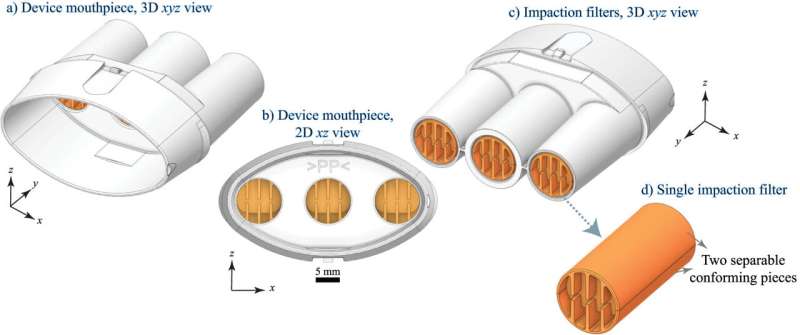This article has been reviewed according to Science X's editorial process and policies. Editors have highlighted the following attributes while ensuring the content's credibility:
fact-checked
peer-reviewed publication
trusted source
proofread
Researchers analyze THC in breath of cannabis smokers

Most states in the U.S. allow people to use cannabis for medical or recreational purposes. Yet all states want their roadways to be safe. A breathalyzer that can accurately identify people who recently smoked cannabis might help them keep impaired drivers off the road—if such a device existed.
But developing a breathalyzer for cannabis is far more difficult than for alcohol, which people exhale in large amounts when drinking. In contrast, the intoxicating component of cannabis, called THC, is thought to be carried inside aerosol particles that people exhale. The total volume of aerosols can be very small, making it difficult to accurately measure their THC content. Currently, there is no standard method for doing this.
Now, researchers at the National Institute of Standards and Technology (NIST) and the University of Colorado Boulder have conducted a study in which they collected breath samples from people both before and after they smoked high-THC cannabis, aka marijuana, and used laboratory instruments (not a handheld device) to measure the amount of THC in their breath.
The goal of this study, published in the Journal of Breath Research, was to begin developing a protocol that yields reproducible results—a necessary step toward a reliable, validated field-based method.
The samples collected before people smoked were important because THC can persist in the bodies of people who frequently use cannabis for a month or more, long after the effects of the drug have worn off.
"One key question that we cannot yet answer is whether breath measurements can be used to distinguish between a person who uses cannabis regularly but hasn't done so lately, and someone who consumed an hour ago," said NIST supervisory chemical engineer and study author Tara Lovestead. "Having a reproducible protocol for breath measurements will help us and other researchers answer that question."
The breath samples were collected in a mobile lab—a comfortably appointed white van that would park conveniently outside participants' homes. This mobile pharmacology lab was developed by researchers at University of Colorado Boulder, including Cinnamon Bidwell, an assistant professor of psychology and neuroscience and a co-author of the study.
In addition, all participants purchased and used a consistent kind of high-THC cannabis prepared by a licensed dispensary in Boulder, Colorado. This study design allowed the authors to conduct their research without handling high-THC cannabis or otherwise running afoul of federal laws.
At the appointed time, participants popped into the van, gave their pre-use breath sample and also provided a blood sample. They then went back into their residence, smoked cannabis according to their usual custom and returned immediately to the van to provide a second blood sample. Since THC concentrations in blood spike immediately after consuming the drug, researchers compared the before-and-after blood samples to confirm that the participants had in fact just used it. An hour later, the participants gave their second breath sample.
Participants provided breath samples by blowing into a tube containing an "impaction filter" that captured aerosols from their breath. Later in the lab, the researchers extracted the material caught in the filter and measured the concentration of THC and other cannabis compounds using liquid chromatography with tandem mass spectrometry, a laboratory technique that identifies compounds and measures their amount.
Because this was a protocol development study that involved only 18 participants, the results of the analysis do not carry statistical weight. However, they do highlight the need for further study.
"We expected to see higher THC concentrations in the breath samples collected an hour after people used," Lovestead said. However, THC levels spanned a similar range across pre-use and post-use samples. "In many cases, we would not have been able to tell whether the person smoked within the last hour based on the concentration of THC in their breath."
"A lot more research is needed to show that a cannabis breathalyzer can produce useful results," said NIST materials research engineer and co-author Kavita Jeerage. "A breathalyzer test can have a huge impact on a person's life, so people should have confidence that the results are accurate."
More information: Kavita M Jeerage et al, THC in breath aerosols collected with an impaction filter device before and after legal-market product inhalation—a pilot study, Journal of Breath Research (2023). DOI: 10.1088/1752-7163/acd410
Journal information: Journal of Breath Research
Provided by National Institute of Standards and Technology



















